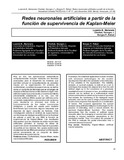| dc.rights.license | http://creativecommons.org/licenses/by-nc-sa/3.0/ve/ | |
| dc.contributor.author | Luzardo B., Marianela | |
| dc.contributor.author | Chediak, Georges J. | |
| dc.contributor.author | Borges P., Rafael E. | |
| dc.date.accessioned | 2009-01-26T15:08:33Z | |
| dc.date.available | 2009-01-26T15:08:33Z | |
| dc.date.issued | 2009-01-26T15:08:33Z | |
| dc.identifier.uri | http://www.saber.ula.ve/handle/123456789/26620 | |
| dc.description.abstract | Hoy en día, las aplicaciones estadísticas computacionales incluyen módulos con técnicas avanzadas para el desarrollo de modelos que permiten simular el comportamiento de variables claves en la organización. El análisis de confiabilidad, o análisis de supervivencia, se define como un conjunto de técnicas que se encargan de analizar el tiempo transcurrido desde el origen bien definido hasta la ocurrencia de un evento de interés previamente establecido; a su vez, una red neuronal artificial (RNA) puede ser definida como un modelo matemático cuya construcción se lleva a cabo mediante un proceso que imita el funcionamiento de las redes neuronales biológicas, y puede ser usada para modelar fenómenos que involucran alguna respuesta que depende de algún conjunto de factores. Esta investigación aborda el análisis de supervivencia con técnicas de inteligencia artificial con la finalidad de estimar a partir de una RNA la función de supervivencia de Kaplan-Meier. Los
resultados demuestran que los modelos de redes neuronales artificiales permiten el manejo de datos de supervivencia sin
necesidad de imponer supuestos de partida en los mismos. Así, queda evidenciado el potencial de las RNApara evaluar la
información parcial proveniente de un conjunto de datos censurados de supervivencia. | es_VE |
| dc.language.iso | es | es_VE |
| dc.rights | info:eu-repo/semantics/openAccess | |
| dc.subject | Confiabilidad | es_VE |
| dc.subject | Redes neuronales artificiales | es_VE |
| dc.title | Redes neuronales artificiales a partir de la función de supervivencia de Kaplan-Meier | es_VE |
| dc.title.alternative | Artificial neural networks since the survival Kaplan-Meier function | es_VE |
| dc.type | info:eu-repo/semantics/article | |
| dc.description.abstract1 | Nowadays, the statistical applications include modules with advanced technologies for the models' development that allow the
simulation of the behaviour of key variables in the organization. The reliability analysis, or survival analysis, is defined
as a set of techniques that analyze the elapsed time from the well defined origin up to the occurrence of a previously established event of interest; in turn, an artificial neural network can be defined as a mathematical model whose construction is carried out by means of a process that imitates the functioning of the biological neural networks, and can be used to shape phenomena that involve some response that depends on a combination of factors. This research approaches the survival analysis using artificial intelligence technologies for the purpose of estimating, since a neural network, the survival Kaplan-Meier function. The results demonstrate that the models of artificial neural networks allow the managing of survival data without needing to impose departure assumptions in the mentioned models. Thus, it is evident the potential of
the RNA to evaluate the partial information from a censured data set of survival. | es_VE |
| dc.description.colacion | 31-39 | es_VE |
| dc.description.email | nela@ula.ve | es_VE |
| dc.description.email | borgesr@ula.ve | |
| dc.publisher.pais | Venezuela | es_VE |
| dc.subject.departamento | Departamento de Contabilidad y Finanzas | es_VE |
| dc.subject.facultad | Facultad de Ciencias Económicas y Sociales | es_VE |
| dc.subject.keywords | Reliability | es_VE |
| dc.subject.keywords | Artificial eural networks | es_VE |
| dc.subject.onomastico | Kaplan-Meier | es_VE |
| dc.subject.publicacionelectronica | Revista Actualidad Contable FACES | es_VE |
| dc.subject.seccion | Revista Actualidad Contable FACES: Artículos | es_VE |
| dc.subject.thematiccategory | Ciencias Económicas y Sociales | es_VE |
| dc.subject.tipo | Revistas | es_VE |
| dc.type.media | Texto | es_VE |


